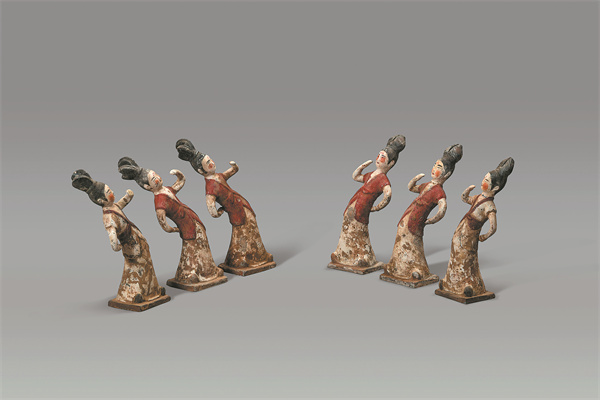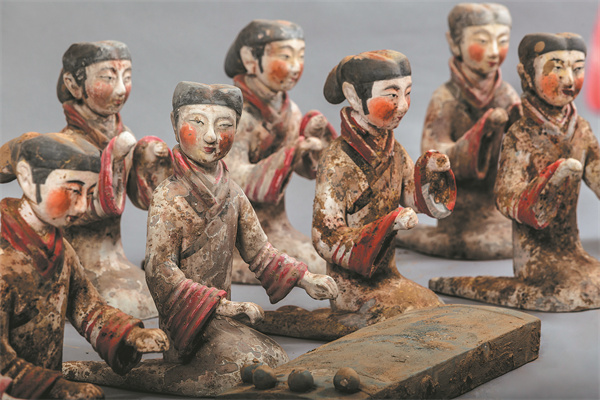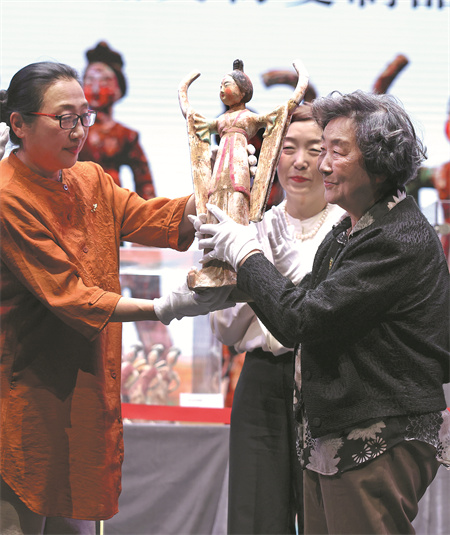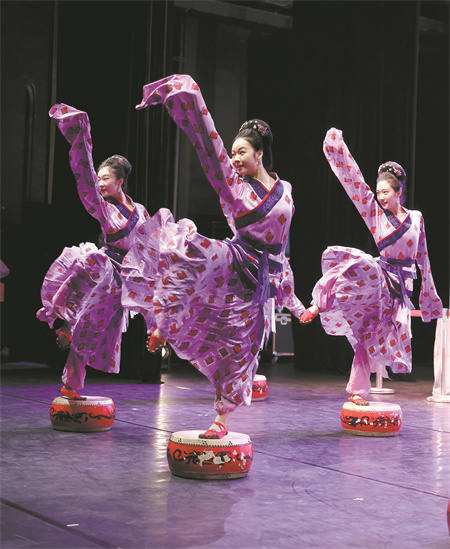Dancing, Motionlessly, through Time
An octogenarian sculptor's childhood experiences with her archaeologist father inspired her to devote her life to creating replicas of ceramic statuettes of women dancers from various dynasties, Chen Nan reports.

Ceramic figurines made by sculptor and cultural relics restoration specialist Wang Qian that are based on Chinese relics from different dynasties.[Photo provided to China Daily]
A female dancer gently bends her knees as her eyes gaze at the floor. Another lifts her heel, raises her arms and tilts her head sideways. They are two clay figurines in a set of eight dancing women created by 80-year-old sculptor and cultural relics restoration specialist Wang Qian.
On May 14, Wang, who previously worked at the Xi'an Beilin Museum — which is home to over 10,000 precious stone carvings and steles — in Xi'an, capital of Northwest China's Shaanxi province, visited the Beijing Dance Academy, a leading dance school in China, founded in 1954.
She has donated 105 sets of dancing figurines, consisting of 353 pieces, which she made from 2015 to 2020, to the institution.
They are replicas of ceramic dancers she saw in museums, books and photos. The originals were sculpted between the Warring States Period (475-221 BC) and the Ming Dynasty (1368-1644).
Some of the originals are housed in such institutions as the Shaanxi History Museum, Xi'an Museum and Xuzhou Museum in Jiangsu province. Some others, unfortunately, only exist in books and photos now.
"I've always loved dancing, ever since I was a kid," says Wang, who started making replicas of dancing clay figurines in 2015 with art students at places like the Xi'an Academy of Fine Arts.
"I've spent my whole life making clay figurines, and dancers are my favorite type."
Wang believes the Beijing Dance Academy is the ideal venue for her works.
"I hope the teachers and students will bring those dancing sculptures alive onstage, allowing more people to enjoy their unique beauty," she says.

Ceramic figurines made by sculptor and cultural relics restoration specialist Wang Qian that are based on Chinese relics from different dynasties.[Photo provided to China Daily]
Family legacy
Wang was born in Xiaoxian county, Suzhou city, East China's Anhui province. She studied at an art school in Xi'an — home to the world-renowned Terracotta Warriors, excavated from Emperor Qinshihuang's Mausoleum Site Museum. In 1979, she became one of the creators of the first life-size Terracotta Warrior replica.
She also won a number of national and international awards, such as the gold award at the 44th edition of the Brussels-Eureka innovation, research and new technologies exhibition in Brussels, Belgium, in 1995. She retired in 2000.
"Although I was retired, one thing lingered in my mind, which compelled me to work again," Wang says.
She recalls that it was her father, renowned painter, sculptor and pioneer of Chinese art archaeology, Wang Ziyun (1897-1990), who inspired her to devote herself into making replicas of dancing clay figurines.
Her father studied sculpture in France in the 1940s and later returned to China, where he and her mother advocated for the establishment of professional teams in art archaeology as part of cultural preservation efforts.

The figurines provide a visual representation of the social life and aesthetics of ancient China.[Photo provided to China Daily]
In 1942, her father went to Luoyang, Central China's Henan province, where he found a group of dancing clay figurines in a mountainside cave. He took photos of these nine sculptures of women in various dance poses.
"I was very excited and intrigued when my dad showed me those photos," Wang Qian recalls.
"Clay figurines of entertainers, such as dancers and musical instrument performers, often accompanied the deceased into the afterlife in ancient China. Those statuettes show the history and culture of their times and are highly valuable as cultural relics.
"Dad was also very excited about those clay figurines, which, sadly, were destroyed in war. He told me he wished to make replicas."
So began her career.
"It's like a promise I made to my father," Wang Qian says.
In 2015, she gave up her relaxing retirement and used her savings to rent a house in the countryside of Xi'an to channel her sculpting skills and restoration experience to produce replicas of ceramic dancers.

Wang and her student, painter and sculptor Xu Yan, display a ceramic dancer they made at the Beijing Dance Academy on May 14.[Photo provided by Zou Hong/China Daily]
When and where
"These silent clay figurines tell stories," says Wang Qian's student, Xu Yan, a painter and sculptor, who has participated in Wang Qian's replica project.
"Their dresses, hairstyles, facial expressions and dance moves all reflect Chinese history during different periods of time. The ceramic statuettes of musicians and dancers provide visual representations of the social life and aesthetics of ancient China."
Xu says she admires Wang Qian's courage and determination in the face of difficulties and challenges that have confronted her on her mission.
"Making replicas of dancing ceramic statuettes is a very complicated process," Xu says.
"Actually, it's not difficult to re-create a dancing figurine based on a photo because, as sculptors, we have the skills to fashion figurines. What challenges us most is conveying the history and culture of when and where the pottery figurine came from."
She adds that Wang Qian has brought many students to visit museums to observe pieces from different dynasties. Wang Qian explained their characteristics, and analyzed and compared their sculptural features and production techniques.
The scholar's ceramic figurines had been displayed in exhibitions in Xi'an, Beijing and Zhengzhou, capital of Henan province, from 2021 to 2023.
During the exhibition in Beijing in April 2021, Wang Qian met faculty members of the Beijing Dance Academy, who then invited her to visit the school.

Students from the Beijing Dance Academy perform Xianghe Ge, adapted from a traditional Han Dynasty (206 BC-AD 220) dance, in Beijing on May 14.[Photo provided by Zou Hong/China Daily]
The academy's Party secretary, Ba Tu, says the school plans to open a museum on its campus to display her sculptures and tell the story of each set.
Teachers with the school's classical Chinese dance department will work together to do research about these figurines and choreograph new dances based on them.
There are many dance pieces born out of the study of ancient Chinese paintings, murals and clay statues.
One is Xianghe Ge, which is adapted from a traditional Han Dynasty (206 BC-AD 220) dance that was often staged during banquets at that time. It was a re-created dance piece performed by female students of the Beijing Dance Academy and by choreographer Sun Ying that later featured in the popular TV show, Wu Qiannian (Dancing Through the Millennium), coproduced by Henan TV and Chinese video platform Bilibili in 2021.
In the performance of Xianghe Ge, the female dancers, wearing costumes of the Eastern Han Dynasty (25-220), chant poems and dance on and off the tops of drums, creating rhythms with their feet. Since it premiered in 2009, the dance piece has become an excerpt of Sun's dance drama, Tongque Ji (Dancing Girl of Tongque Platform).
Such modern presentations of ancient Chinese dances have been gaining popularity among the younger generation. The viral dance piece, A Tang Dynasty Banquet, produced and staged by Henan TV in 2021, portrays such national treasures as Tang Dynasty (618-907) clay figurines.
"Those dances bring ancient ceramic statuettes to life and tell their stories onstage, which is a creative approach to showcasing the treasures," says Xu Rui, president of the Beijing Dance Academy.
"Thanks to Wang Qian, we have these dancing figurines, which will inspire us to be creative and imaginative with the choreography."
